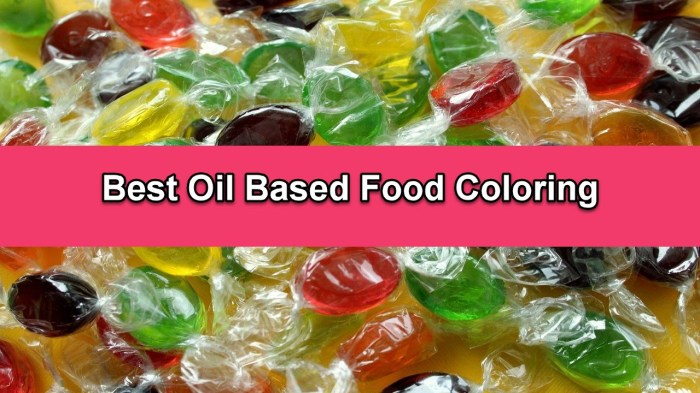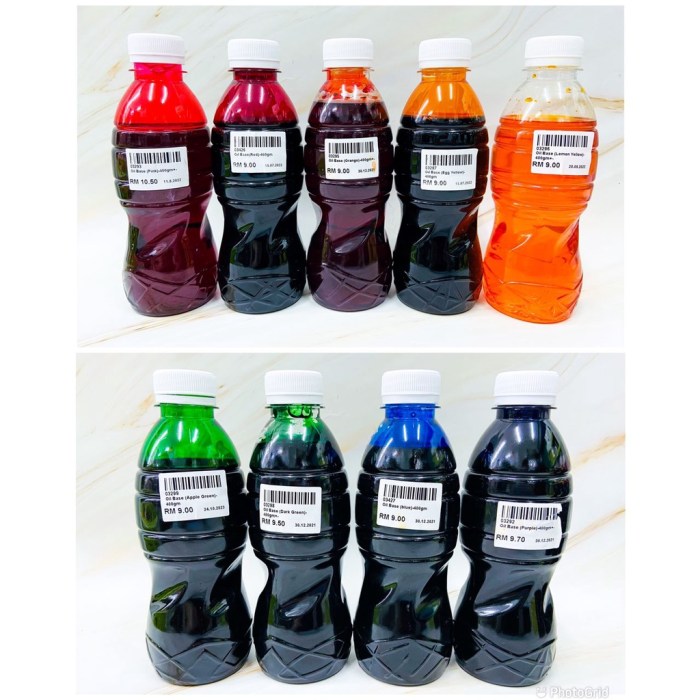Oil Based Food Coloring Walmart A Comprehensive Guide
Comparison with Water-Based Food Coloring

Oil based food coloring walmart – Friends, fellow culinary adventurers! Today, we delve into the fascinating world of food coloring, specifically contrasting the titans of the industry: oil-based and water-based colorants. Understanding their unique properties is crucial for achieving the vibrant, mouthwatering results you envision in your culinary creations. We’ll explore their strengths and weaknesses, guiding you towards making informed decisions in your kitchen.Oil-based and water-based food colorings possess fundamentally different characteristics, impacting their suitability for various applications.
Water-based colorings, as the name suggests, disperse readily in water-based mixtures, making them ideal for cakes, frostings, icings, and other aqueous-based recipes. Oil-based colorings, on the other hand, are designed for integration into oil-based mediums like melted chocolate, batters containing substantial amounts of oil, or even some types of candy. This inherent difference significantly influences their performance and final product appearance.
Walmart’s selection of oil-based food coloring offers vibrant hues ideal for various culinary creations. Understanding how these colors interact with different liquids is key; for instance, you can explore fascinating surface tension effects by checking out this informative guide on experiment with food coloring and milk. This knowledge can then be applied to refine your use of oil-based food coloring from Walmart, resulting in more visually appealing and professional-looking results.
Oil-Based Coloring Advantages and Disadvantages in Baking and Cooking
Oil-based food colorings offer a unique advantage in applications where intense color saturation is desired without significantly altering the texture or consistency of the final product. Their concentrated pigment allows for achieving vivid hues with minimal addition. However, they require careful handling, as improper mixing can lead to uneven color distribution or separation in water-based mixtures. Their inherent oiliness can also affect the overall texture of some recipes if not incorporated correctly.
Conversely, water-based colorings, while easier to incorporate, might result in less intense colors in some applications and can sometimes alter the texture of delicate recipes.
Examples of Food Items Suitable for Each Coloring Type
Let’s look at some practical examples. Imagine crafting exquisitely detailed fondant decorations for a wedding cake. Oil-based food coloring would be your champion here, allowing for rich, vibrant colors that won’t bleed into the fondant. Conversely, when preparing a vibrant fruit punch, a water-based coloring would be far more suitable, ensuring seamless integration and even color distribution throughout the beverage.
Similarly, a creamy, oil-rich frosting would benefit from the intense color payoff of an oil-based coloring, while a delicate sponge cake might be better served with the gentler influence of a water-based option. Consider the final texture and consistency of your recipe as a key factor in your decision-making process. The right coloring will elevate your culinary creations from good to truly spectacular!
Ingredient Analysis and Safety

Choosing food coloring can feel like navigating a minefield, especially when considering the differences between oil-based and water-based options. Understanding the ingredients and their potential impact on your health is crucial for informed decision-making. This section will delve into the typical components of oil-based food colorings available at Walmart and assess their safety profiles.
Oil-based food colorings often utilize a blend of ingredients designed for fat-soluble applications. These differ significantly from their water-based counterparts, leading to variations in both application and potential safety considerations. Let’s explore these differences in detail.
Typical Ingredients in Walmart Oil-Based Food Colorings
While specific formulations vary by brand, typical ingredients in oil-based food colorings found at Walmart often include:
- Oil (e.g., soybean oil, sunflower oil): This acts as the base, dissolving the colorants and enabling smooth incorporation into fatty foods.
- Synthetic Food Colorants (e.g., Yellow 5, Yellow 6, Red 40, Blue 1): These provide the vibrant hues. Their safety is a subject of ongoing debate, with some individuals expressing concerns about potential hyperactivity or allergic reactions.
- Antioxidants (e.g., BHA, BHT): These preservatives help prevent the oil from oxidizing and becoming rancid, extending the shelf life of the product.
Potential Safety Concerns Associated with Ingredients
Certain ingredients in oil-based food colorings raise potential safety concerns. It’s vital to understand these concerns and make informed choices based on your individual needs and preferences.
- Synthetic Food Dyes: The long-term effects of consuming synthetic food dyes are still being studied. Some research suggests a potential link between these dyes and hyperactivity in children, although more research is needed to confirm this definitively. Allergic reactions are also possible.
- Antioxidants (BHA, BHT): These are preservatives used to extend shelf life. While generally considered safe at approved levels, some studies have raised concerns about potential links to certain health issues, although the evidence is not conclusive. It’s important to note that these concerns often relate to high levels of consumption over extended periods.
Comparison of Ingredient Lists from Three Walmart Brands, Oil based food coloring walmart
The following table compares the ingredient lists of three hypothetical oil-based food coloring brands (Brand A, Brand B, Brand C) found at Walmart. Note that actual ingredient lists may vary depending on the specific product and batch.
| Ingredient | Brand A | Brand B | Brand C |
|---|---|---|---|
| Oil Base | Soybean Oil | Sunflower Oil | Soybean Oil |
| Yellow 5 | Present | Present | Absent |
| Yellow 6 | Absent | Present | Present |
| Red 40 | Present | Present | Present |
| Blue 1 | Present | Absent | Present |
| BHA | Present | Absent | Present |
| BHT | Absent | Present | Absent |
FAQ Compilation: Oil Based Food Coloring Walmart
What is the difference in taste between food colored with oil-based and water-based coloring?
Generally, oil-based food coloring imparts minimal to no discernible taste difference in most recipes. Water-based colorings can sometimes have a slightly sweeter taste, though this is often negligible.
Can oil-based food coloring be used in all types of recipes?
While versatile, oil-based coloring is best suited for recipes with oil or fat content, such as cakes, frostings, and some candies. It may not disperse well in purely water-based recipes.
How do I clean up spills of oil-based food coloring?
Act quickly! Use a mild dish soap and warm water to clean up spills immediately. For stubborn stains, consider a grease-cutting cleaner.
Are there any specific health concerns related to the consumption of oil-based food coloring?
Always check the ingredient list for any potential allergens or sensitivities. If you have specific dietary concerns, consult a healthcare professional or review the manufacturer’s information.
